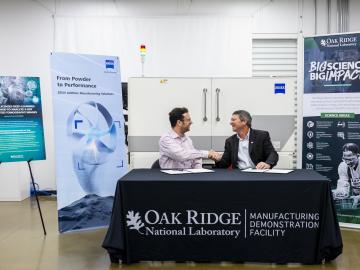
Filter News
Area of Research
- Advanced Manufacturing (2)
- Biology and Environment (9)
- Computer Science (1)
- Energy Science (18)
- Fusion and Fission (5)
- Isotope Development and Production (1)
- Isotopes (15)
- Materials (34)
- Materials for Computing (2)
- National Security (19)
- Neutron Science (9)
- Nuclear Science and Technology (6)
- Quantum information Science (1)
- Sensors and Controls (1)
- Supercomputing (13)
News Type
News Topics
- (-) Cybersecurity (23)
- (-) Isotopes (33)
- (-) Partnerships (33)
- (-) Physics (42)
- (-) Security (19)
- (-) Space Exploration (3)
- 3-D Printing/Advanced Manufacturing (61)
- Advanced Reactors (14)
- Artificial Intelligence (44)
- Big Data (20)
- Bioenergy (48)
- Biology (53)
- Biomedical (30)
- Biotechnology (17)
- Buildings (25)
- Chemical Sciences (44)
- Clean Water (9)
- Composites (15)
- Computer Science (77)
- Coronavirus (23)
- Critical Materials (13)
- Education (3)
- Element Discovery (1)
- Energy Storage (56)
- Environment (78)
- Exascale Computing (16)
- Fossil Energy (1)
- Frontier (19)
- Fusion (26)
- Grid (23)
- High-Performance Computing (43)
- Hydropower (2)
- ITER (3)
- Machine Learning (23)
- Materials (69)
- Materials Science (71)
- Mathematics (5)
- Mercury (6)
- Microelectronics (1)
- Microscopy (28)
- Molten Salt (3)
- Nanotechnology (35)
- National Security (35)
- Neutron Science (64)
- Nuclear Energy (44)
- Polymers (18)
- Quantum Computing (14)
- Quantum Science (36)
- Simulation (18)
- Statistics (1)
- Summit (24)
- Transportation (38)
Media Contacts

As vehicles gain technological capabilities, car manufacturers are using an increasing number of computers and sensors to improve situational awareness and enhance the driving experience.

The Department of Energy’s Oak Ridge National Laboratory and Tennessee State University have signed a memorandum of understanding to strengthen research cooperation and provide diverse undergraduate students enriching educational research opportunities at the lab.

ORNL and the University of Texas Rio Grande Valley, known as UTRGV, have signed a memorandum of understanding to strengthen research cooperation and establish a collaborative program for undergraduate research and education, further cementing hi

Susan Hubbard, diputada de Ciencia y Tecnología en ORNL, Can (John) Saygin, vicepresidente mayor de investigación y decano del Colegio de la Escuela de Postgrados en UTGRV, firman un Memorándum de Entendimiento comprometiéndose a fortalecer

The Department of Energy’s Oak Ridge National Laboratory announced the establishment of the Center for AI Security Research, or CAISER, to address threats already present as governments and industries around the world adopt artificial intelligence and take advantage of the benefits it promises in data processing, operational efficiencies and decision-making.

Carl Dukes’ career as an adept communicator got off to a slow start: He was about 5 years old when he spoke for the first time. “I’ve been making up for lost time ever since,” joked Dukes, a technical professional at the Department of Energy’s Oak Ridge National Laboratory.

ORNL has launched a new entrepreneurial start-up program, Safari, as an addition to DOE's Office of Technology Transitions Practices to Accelerate the Commercialization of Technologies program. Safari seeks to connect post-exit entrepreneurs with commercially relevant technologies developed by world-leading scientific experts, which could provide the basis for a new business.

Madhavi Martin brings a physicist’s tools and perspective to biological and environmental research at the Department of Energy’s Oak Ridge National Laboratory, supporting advances in bioenergy, soil carbon storage and environmental monitoring, and even helping solve a murder mystery.

A licensing agreement between the Department of Energy’s Oak Ridge National Laboratory and research partner ZEISS will enable industrial X-ray computed tomography, or CT, to perform rapid evaluations of 3D-printed components using ORNL’s machine

Mike Huettel is a cyber technical professional. He also recently completed the 6-month Cyber Warfare Technician course for the United States Army, where he learned technical and tactical proficiency leadership in operations throughout the cyber domain.


